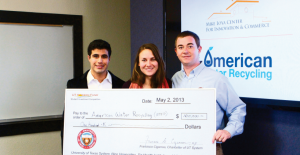By Daniel Perez
Three students – Eva Deemer, Diego Capeletti, and Alex Pastor – spent several months creating a business plan that capitalized on Deemer’s research into graphene, a thin and strong carbon-based substance used to recycle water in an affordable, environmentally friendly way.
They worked with UTEP’s Center for Research Entrepreneurship and Innovative Enterprises (CREIE) and Mike Loya Center for Innovation and Commerce to enhance their knowledge and refine their presentation.

Pastor, Eva Deemer and Diego Capeletti, plan to test their
recycling technology on a commercial scale in August
2013. “Now things get real,” Deemer said.
The trio’s American Water Recycling (AWR) plan won the Paso del Norte (PDN) Venture Competition at UTEP in March ($10,000) and the UT Horizon Fund Student Investment Competition in Austin in early May ($100,000). About the same time, the team finished in the Top 10 at the Global Venture Labs Investment Competition, considered the Super Bowl of student venture contests. They competed against about 40 teams from top universities around the world. AWR also received a “seed” grant for the commercialization of their product by a UT System program that promotes innovation among UT campuses. Altogether they earned $121,750.
AWR, an incorporated business, invested its winnings into a commercial pilot program that it planned to launch in August 2013 in Las Cruces, N.M., to test the recycling process and validate their technology.
“Now things get real,” said Deemer, a doctoral student in materials science and engineering.
Deemer, an El Paso native, earned her bachelor’s degree in chemistry from UTEP in 2008. As an undergraduate she was part of a team that received a patent for a method to measure biodiesel composition. After working in research and development for several El Paso-based energy companies, she returned to UTEP to work on her doctorate and decided to focus her research on graphene. She responded to a CREIE suggestion to get involved in the PDN competition, but she needed partners who knew business.
She was introduced to Pastor, a junior economics major who was an intern with the Hub of Human Innovation, an El Paso technology incubator that helps develop technology-based businesses. His duties included editing business plans and conducting market research. The El Paso native had earned an entrepreneurial scholarship and a national award for operating his own seafood stand. He wanted to participate in the competition and went to CREIE, where he met Deemer.
Pastor could market Deemer’s technology, but knew they needed someone with a stronger financial background, so he called fellow Hub intern Capeletti, an Argentine native who enrolled in UTEP’s M.B.A. program in 2011. He had participated in the 2012 PDN. Although his team lost, his written business plan was judged the best.
The trio spent long hours working and reworking every aspect of their plan until they were confident it was ready. They are proud of their achievements and grateful for the structure and constructive criticism they received through CREIE and the Loya Center.
Officials with the two centers said the AWR results are an example of how UTEP students can use what they learn in the classroom and, with the centers’ guidance, learn how to turn that information into a successful business.
“There are other AWRs out there and we have to identify them,” said David Novick, Ph.D., professor of computer science and a co-director of the Loya Center. “We want to inspire those students who have significant technological ideas but don’t understand their commercial potential.”
The two-year-old Loya Center is a partnership between the University’s colleges of Engineering and Business Administration. It is focused on developing technology, and business and academic processes that will help students gain real-world experience as they create companies that could boost the region’s economy.
Gary Frankwick, Ph.D., professor of marketing and management and the center’s other co-director with Novick, said the Loya Center looks forward to working with students with bold ideas.
“If you’re going to be an innovator and an entrepreneur, you have to think big to change the world,” he said.
Frankwick said the Loya Center, which is focused on research of entrepreneurship, innovation and commercialization, complements the work done by CREIE, which is directed more toward implementation and product launch.
Gary Williams, Ph.D., CREIE director, said the four-year-old center guides students through the innovation process from concept through commercialization. He said he is working with his counterparts at the Loya Center and the Hub of Human Innovation to maximize collaboration and minimize duplication of services.
Williams, who has more than 40 years of executive experience with multimillion-dollar companies, said engineers and business types do not always speak the same language, but they quickly understand the value of the other.
“It doesn’t matter to us where the idea comes from. All we want is somebody that has the passion and the interest and is willing to take the time to learn,” Williams said. “Going forward, things are only going to get brighter. This story is just beginning.”